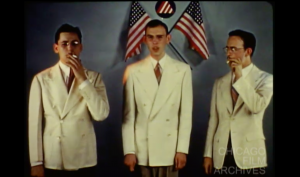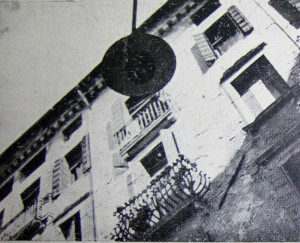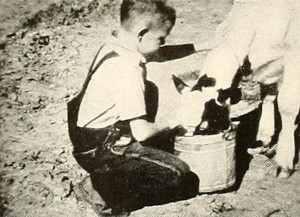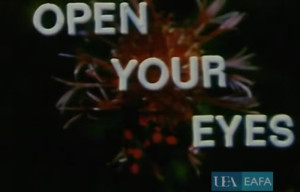"doc. didattico"/educational film
"A New Life for Jennifer is the sensitive story of a little girl about 4 years of age who is hard of hearing. She is enrolled in a special school for hard of hearing children where she learns to talk and speak correctly and in other ways to manage herself. The techniques used in theses teaching processes are emphatically depicted, and the judges did well in awarding to the maker of this film a citation which reads "For Special Service in the Public Interest" PSA Journal, Sept. 1965, 51.
"documentario"/documentary
"...illustra un'ardita ascensione degli allievi della Scuola di alpinismo di Chiareggio, con cordate che salgono gli straptombi alla ricerca del falco abitatore delle vette"
"...illustrates a daring ascent of the students of the School of Mountaineering of Chiareggio, with ropes that climb the overhangs in search of the hawk that inhabits the peaks."
—"I Littoriali del cinema: i documentari della prima giornata," La Stampa, September 2, 1939"
"Numerical Order is a learning-how-to-count film. Through some very beautiful art work, paste-up, and other production techniques, Bill Peterson shows how to count. He has found a reason for every number up to 100. Your better judgement tells you he couldn't possibly keep up his starting pace until reaching 100, but he does except for one little bit of cheating. A film like this must have taken a million hours of patience to produce in addition to a lot of talent" PSA Journal, Oct. 1968, 48.

"Three men encourage people to follow rules set by the air raid warden in the event of an air raid. The rules are put to song, and some rules are depicted by actors." Chicago Film Archives
"Of Kings And Queens: This Kodachrome entry endeavors to explain the game of chess to a little girl watching it being played by her father and a friend. Moving in close to the chess board, the camera shows in detail the various chess men and their relation to the game, as an off-stage voice explains this relationship to the girl. C. Richmond Lawrence employed his Bolex H-16 camera with great skill in photographing this film, and the narration on the sound track is of high calibre." American Cinematographer, May. 1951, 192.

"doc. a fantasia"/avant-garde documentary

"On the Farm, made by Mr. and Mrs. Ray Garner for the Harmon Foundation, is an example of visual education at its best. By the use of two charming, healthy little American children as the chief characters, it enlists sympathy before it attempts to instruct. And it never strays from the fundamental concept which, to all evidence, was in the minds of its makers: namely that, to teach children by visual aids, one must appeal to their sense of fun. Charm, here, is not outlawed simply because it is not informative. Divided into two parts, Morning and Afternoon, and illustrated with unpretentious titles, such as This is how the animals help, which are chalked in white letters on a blackboard, On the Farm tells of a common workday, in terms of what two farm children can do to assist their parents. From the sequence in which the tousled farm lad puts his head out of the window to see what kind of a daybreak it is. to the time when the sun goes down behind the silo, almost every kind of farm activity is shown. Other children in city classrooms are going to see themselves in the scenes and will want to learn more about a way of life in which they can feel so much at home." Movie Makers, Dec. 1940, 600-601.

'Amateur filmmaker Dorothy Maxey observes the wildlife in her native Norfolk capturing on Super 8 film a variety of interesting flora and fauna, including at Thompson Common where ponies wade into the pingos and steal the heads from the water violets, and in her own back garden stumbling across wrestling toads. The filmmaker also recalls a story of nursing a poorly mouse following a frosty night by returning home with it to kindly warm him up under the oven grill' (EAFA.org.uk)

"Footage along the American River that was used to save the American River Parkway." Sacramento Public Library.
Total Pages: 14